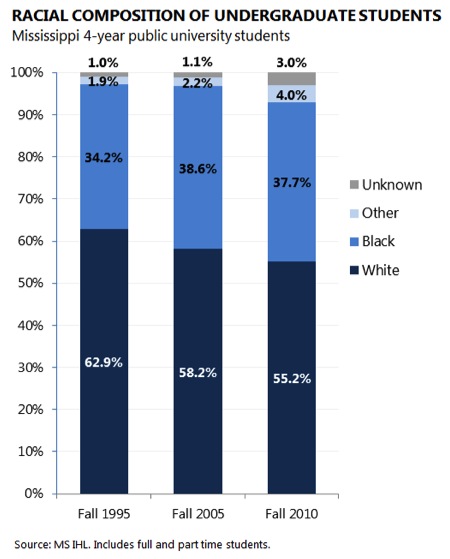MISSISSIPPI UNIVERSITIES AND THE GREAT COST SHIFT
April 30th, 2012
Recently, both the cost of higher education and student loans have been elevated to the nation’s attention. Here in Mississippi, funding for higher education is in focus as legislators make appropriation decisions for the upcoming year.
A new report, The Great Cost Shift: How Higher Education Cuts Undermine the Future Middle Classreviews how changes in funding for higher education over the last two decades have affected students and households across the country. This report examines how state disinvestment in public higher education over twenty years has shifted costs to students and their families.
This cost shift to families and students is evident in Mississippi as well as universities plan to raise tuition over the next two years to help cover costs and fill gaps in funding in the wake of growing enrollment and capped state funding.
As is seen nationally, the change in the balance of funding for higher education has come as Mississippi’s university student population is growing and becoming more diverse racially and economically. Over the last 15 years, the number of minority students enrolling in Mississippi’s universities has grown substantially (see chart).
At the same time, the number of students accessing Pell grants to support some of their education costs is rising. In 2009, more than 24,000 university students received some level of Pell grant funding.
In addition, more than half of Mississippi’s public 4-year university students now take out student loans to finance a portion of their education.¹
As noted in the report, as Mississippi’s university student population shifts, so, too, do the needs of students. First generation college students, students in need of remediation, or non-traditional students who are working while in school are just a few groups that may need extra support and resources as they move through higher education.
Mississippi and other states face the challenge of meeting these varied needs in a financial climate of scarcity that has persisted for a number of years. Recognizing the changing student needs –in both financial and academic support- is critical for also allocating sufficient funding to Mississippi’s post-secondary institutions, and thereby ensuring more students successfully attain a university degree and opportunities for longer-term economic prosperity.
¹Mississippi Institutions of Higher Learning. Data from Enrollment in FY2008-2009. Includes full and part time enrollment.






